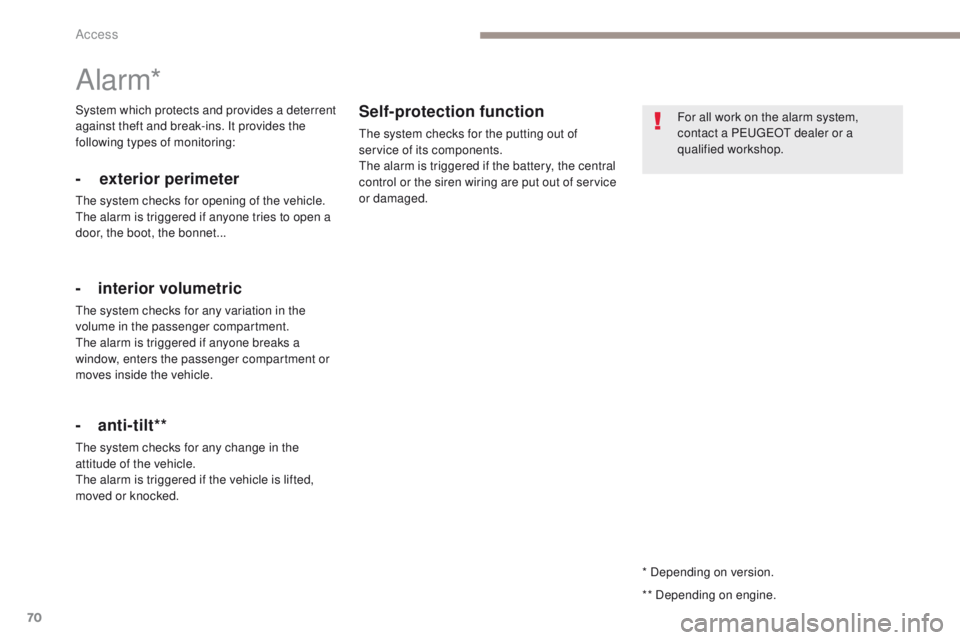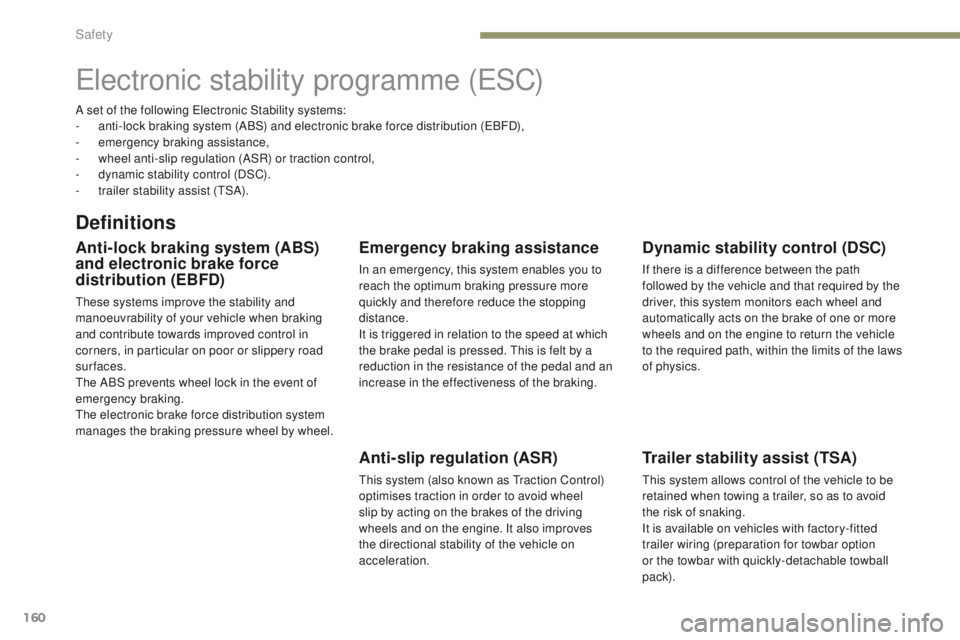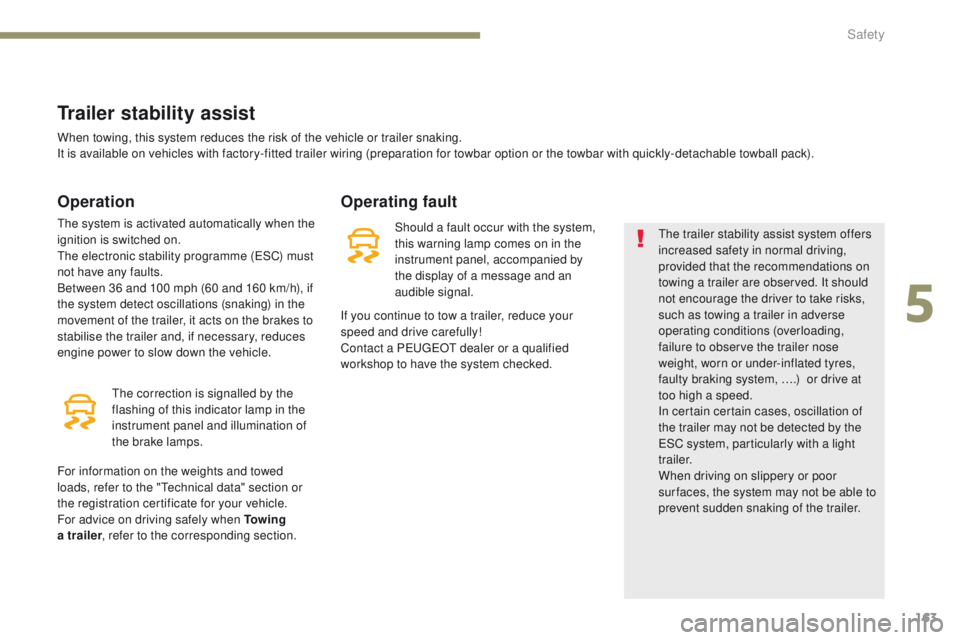Page 72 of 566

70
3008-2_en_Chap02_ouvertures_ed01-2016
* Depending on version.
Alarm*
- exterior perimeter
The system checks for opening of the vehicle.
The alarm is triggered if anyone tries to open a
door, the boot, the bonnet...
- interior volumetric
The system checks for any variation in the
volume in the passenger compartment.
The alarm is triggered if anyone breaks a
window, enters the passenger compartment or
moves inside the vehicle.
- anti-tilt**
The system checks for any change in the
attitude of the vehicle.
The alarm is triggered if the vehicle is lifted,
moved or knocked.
Self-protection function
The system checks for the putting out of
service of its components.
The alarm is triggered if the battery, the central
control or the siren wiring are put out of service
or damaged. For all work on the alarm system,
contact a PEUGEOT dealer or a
qualified workshop.
** Depending on engine.
System which protects and provides a deterrent
against theft and break-ins. It provides the
following types of monitoring:
Access
Page 162 of 566

160
3008-2_en_Chap05_securite_ed01-2016
Electronic stability programme (ESC)
Definitions
Anti-lock braking system (ABS)
and electronic brake force
distribution (EBFD)
These systems improve the stability and
manoeuvrability of your vehicle when braking
and contribute towards improved control in
corners, in particular on poor or slippery road
surfaces.
The ABS prevents wheel lock in the event of
emergency braking.
The electronic brake force distribution system
manages the braking pressure wheel by wheel.
Emergency braking assistance
In an emergency, this system enables you to
reach the optimum braking pressure more
quickly and therefore reduce the stopping
distance.
It is triggered in relation to the speed at which
the brake pedal is pressed. This is felt by a
reduction in the resistance of the pedal and an
increase in the effectiveness of the braking.
Anti-slip regulation (ASR)
This system (also known as Traction Control)
optimises traction in order to avoid wheel
slip by acting on the brakes of the driving
wheels and on the engine. It also improves
the directional stability of the vehicle on
acceleration.
Dynamic stability control (DSC)
If there is a difference between the path
followed by the vehicle and that required by the
driver, this system monitors each wheel and
automatically acts on the brake of one or more
wheels and on the engine to return the vehicle
to the required path, within the limits of the laws
of physics.
A set of the following Electronic Stability systems:
-
a
nti-lock braking system (ABS) and electronic brake force distribution (EBFD),
-
em
ergency braking assistance,
-
w
heel anti-slip regulation (ASR) or traction control,
-
d
ynamic stability control (DSC).
-
t
railer stability assist (TSA).
Trailer stability assist (TSA)
This system allows control of the vehicle to be
retained when towing a trailer, so as to avoid
the risk of snaking.
It is available on vehicles with factory-fitted
trailer wiring (preparation for towbar option
or the towbar with quickly-detachable towball
pack).
Safety
Page 165 of 566

163
3008-2_en_Chap05_securite_ed01-2016
Trailer stability assist
Operation
The system is activated automatically when the
ignition is switched on.
The electronic stability programme (ESC) must
not have any faults.
Between 36 and 100 mph (60 and 160 km/h), if
the system detect oscillations (snaking) in the
movement of the trailer, it acts on the brakes to
stabilise the trailer and, if necessary, reduces
engine power to slow down the vehicle.
For information on the weights and towed
loads, refer to the "Technical data" section or
the registration certificate for your vehicle.
For advice on driving safely when To w i n g
a trailer , refer to the corresponding section.
When towing, this system reduces the risk of the vehicle or trailer snaking.
It is available on vehicles with factory-fitted trailer wiring (preparation for towbar option or the towbar with quickly-detachable towball pack).
The correction is signalled by the
flashing of this indicator lamp in the
instrument panel and illumination of
the brake lamps.
Operating fault
Should a fault occur with the system,
this warning lamp comes on in the
instrument panel, accompanied by
the display of a message and an
audible signal.
If you continue to tow a trailer, reduce your
speed and drive carefully!
Contact a PEUGEOT dealer or a qualified
workshop
to have the system checked. The trailer stability assist system offers
increased safety in normal driving,
provided that the recommendations on
towing a trailer are observed. It should
not encourage the driver to take risks,
such as towing a trailer in adverse
operating conditions (overloading,
failure to observe the trailer nose
weight, worn or under-inflated tyres,
faulty braking system, ….)
or drive at
too high a speed.
In certain certain cases, oscillation of
the trailer may not be detected by the
ESC system, particularly with a light
t r a i l e r.
When driving on slippery or poor
sur faces, the system may not be able to
prevent sudden snaking of the trailer.
5
Safety
Page 287 of 566
285
3008-2_en_Chap07_infos-pratiques_ed01-2016
Towbar with quickly detachable towball
Presentation
A. Locked position
The latch is positioned to the right.
The trigger is facing toward the rear.
B. Unlocked position
The latch is positioned to the left.
The trigger is facing toward the front.Observe the legislation in force in the
country in which you are driving.
For information on the trailer weights
for your vehicle, refer to the "Technical
data" section.
For driving safely when Towing a
trailer, refer to the corresponding
section.
No tools are required to install or remove the
towball on this genuine towbar system.
1.
Carrier.
2.
P
rotective plug.
3.
S
afety eye.
4.
T
rauiler wiring harness connection socket.
5.
D
etachable towball.
6.
L
ocking / unlocking latch.
7.
L
ocking / unlocking trigger.
8.
K
ey-operated safety lock.
9.
S
afety lock protective cap.
10.
S
towing bag.
7
Practical information
Page 290 of 566
288
3008-2_en_Chap07_infos-pratiques_ed01-2016
Removing the towball
F Attach the trailer to the towball.
F A ttach the trailer safety cable to the eye
provided on the towball carrier.
F
R
aise the protective cover on the socket
and connect the trailer wiring harness. F
D isconnect the trailer wiring harness from
the socket on the carrier.
F
D
etach the trailer safety cable from the eye
on the carrier.
F
D
etach the trailer from the towball.
F
U
nclip and remove the protective cap, by
turning it to the right.
F
I
nsert the key in the lock and turn it to the
left.
F
R
emove the key from the lock.
Practical information